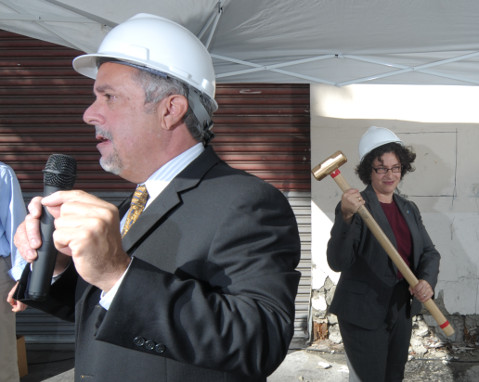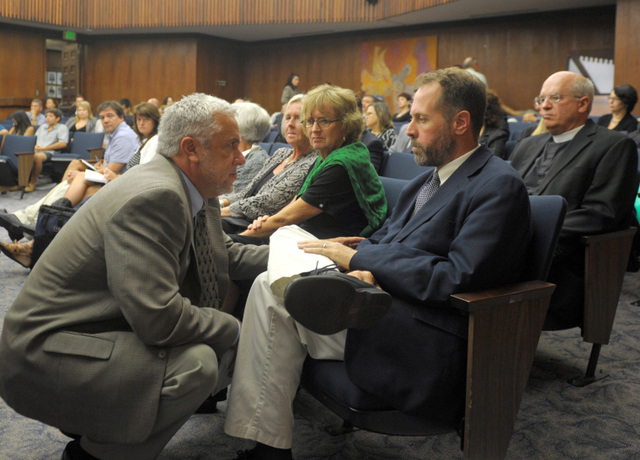Housing: A Conversation with Rob Pearson
Retiring City Housing Director Reflects on Density, Investors, and Home Ownership

Like the weather, people complain a lot about Santa Barbara’s excruciatingly unaffordable housing market. For 36 years, Rob Pearson has actually done something about it. During his 36 years at the helm of the Housing Authority of the City of Santa Barbara — 30 as executive director and six as second-in-command — Pearson developed 40-50 housing projects, building 3,200 units of affordable housing for low-income renters, including Section 8. In terms of scale, scope, and magnitude, that puts him on par with regional mega-developers like Michael Towbes.
Under Pearson, the Housing Authority managed the seemingly impossible, shoe-horning mid-sized developments into tight spaces without generating intense backlash from neighborhood residents. By Santa Barbara standards, that’s akin to walking on water. Pearson — who retired late last December — credited compatible design and solid management for the before and after success of agency projects.
Pearson may have made a point of walking softly, but he also carried a big stick. He was not an easy foe to cross. Pearson did not single-handedly bring the curtain down on Santa Barbara’s burgeoning vacation rental industry. But when he got involved — issuing white papers on the impact of vacation rental industry’s impact on rental housing — it was the beginning of the political end for that industry. Before officially passing the baton to his second in command, Rob Fredericks, Pearson spent some time talking with Independent writer Nick Welsh. The following is an edited version of that conversation.
The housing market has always been ridiculously expensive in Santa Barbara. How is it any different now? It’s never been this bad. The middle class used to be able to buy into the community and be part of it. Goleta was built to house UCSB professors and people working for research and development companies, very middle-class jobs. Even I could make the leap into home ownership. I now live in a condo on the Riveria. It’s in the million-buck price range. I’m not sure I could afford to go buy that today, even on my good salary.
So how is it worse? It’s a lot worse because the vacancy rate is down. I kind of put all this at the doorstep of our growing income inequality in the country and in the world. Desirable places will get picked up by people with money, and we haven’t done any deep dive into the second-home phenomena which is occurring here in S.B.
People have what they call ghost apartments. It’s not a bad investment, and people want to own a piece of Santa Barbara whether they use it or not. I live in a 38-unit complex. When I moved in, we were all owner-occupants. Now four of them are second homes.
Homeowners get a big mortgage tax deduction. It saves me about $5,000 a year. Our housing is effectively subsidized. The loss to the federal treasury is estimated between $90 billion and $120 billion a year depending on whose study you use. All that is designed to encourage home ownership. But renters are left out in the cold. If you’re a renter, you don’t get that kind of subsidized tax break.
We’re hearing people talk about rent control for the first time in decades. I wasn’t sure it was still legal. The City of Alameda, which is very similar to us, just adopted rent stabilization which allows maximum rent increases a year of 5 percent. If you want more than 5 percent a year, you have to justify it.
How is rent stabilization different from rent control? It still allows annual increases, and it allows a formula, and there is no cap. If you make a case that you deserve more than 5 percent, you get to make that case. Voters in Alameda approved that in March. But they also have just cause eviction, which basically says if you’re going to evict someone for any other reason than not paying the rent or violating the lease, you pretty much got to pay them $1,500 for moving expenses and one month’s rent for each year of tenancy with a four-month maximum. So if you’re paying $2,000 a month, you could walk away with $9,500. At least you get some money to go looking for something.

I hear landlords say 15 percent of our housing stock is affordable, that we’re doing as much as can be humanly expected and far more than other communities. In that context, they say rent control would be unfair. It’s more like 12 percent. I think we’ve done a fairly good job taking care of the poor. But it’s the middle class we need to think about. In this country, only one in four of the people who qualify for federally assisted housing actually get it because of lack of supply. I’m worried about the mom who’s working two jobs and has two kids and is on our waiting list. People like that have no protection, no just-cause eviction. I’ve heard so many horror stories. I’ve had people with good-paying jobs call me and say, “I don’t have any place to go. I can’t find anything, and I can’t afford $2,000 a month.”
You mentioned subsidized housing. How many Section 8 voucher holders does the Housing Authority have? Two thousand, four hundred.
If the Trump administration’s proposed cuts go through, how many fewer will there be? Probably a 100.
How long is your waiting list? We’re close to about 6,000 households on the waiting list
That sounds like a lot. Almost every housing authority in the country has got horrendous waiting lists. There are stories in some communities that when their housing authority opens their waiting list, they get 20,000 applications in two days. Just, boom! There are lines around the building. When we open and close now, we insist you apply by mail. Otherwise we’d have people camping out front.
Any thoughts on the city’s AUD (average-size unit density) program designed to stimulate developers to build rental housing? My biggest worry remains the middle class in our community. I don’t think that middle-class people in places like Santa Barbara can expect to become homeowners. Now I’m wondering if they can even be renters. These new AUD units are coming out at price points that are pretty damn high. I think the program should be tweaked a little bit to make a portion of the new units affordable to people earning between 80 percent of area median income and 120 percent. That to me is the true missing middle. We at the Housing Authority serve people making 80 percent and below. The AUD units coming online are serving people who make 160-200 percent of area median. If we’re going to give density bonuses to developers, they should target some portion to that missing middle.
In part due to the AUD program, developers are building rental units like never before, which is what people have been saying they want. But the City Council is freaking out and wants to put the brakes on. Why is that? Because it is changing the landscape, and we’ve always been crazy about making sure that our neighborhoods are preserved. I think you’re seeing three-story proposals pop up downtown and next to single-family homes. It’s changing the character of the neighborhood, and people are upset about that. And the parking issues downtown are a problem. I think they will resolve in the long-term because the whole way of transportation is going to change. Cars sit idle 80 percent of the time. Do we really need all this real estate set aside for parking? That’s where the sharing economy makes sense.

How are the politics of City Hall different today in regard to housing then when you were coming up? I think the councils tended to be a little more liberal in the older days. And there are a lot more haters out there. “Why should I be paying for that person?” It’s as if the right to travel and go from community to community is restricted just to the wealthy. And if you’re homeless, let’s throw away the Constitution.
I would love to see every community say, “Okay, we’re going to provide housing for up to X percent of our population who are homeless.” You know, most communities have a homeless population between 1-2 percent if you run the numbers. A lot of what happened was the loss SRO (single-room occupancy) hotels. We used to have 700 SRO units that are now gone. Every community used to have their Skid Row. You and I may not want to live there, but it was perfectly good, and the private sector did it. In this country, our government-financed housing for the poor is maybe 10 percent nationally when you add all the programs together. Most countries do 30 percent.
The problems with housing and homelessness seem bigger than ever despite massive efforts. A lot of people say, “Why bother? What’s the point?” We’d be that much worse without trying. The homeless population would be that much worse without it, and we would see more elderly. This country is in for a big wake-up call. In 2030, one in five of us will be over 65. That’s 70 million Americans who are not prepared for retirement. I know so many people who only have Social Security and don’t own shit, and they’re going to retire at $950 a month on Social Security. And these are people that worked all their lives. What is our community response? Do we have any obligation to them? These are the things that keep me up at night, and I don’t have the answer, so there is a little bit of burnout on my part.
Can you handle retirement? I’m grateful for the work, and I think we did the right thing. I don’t want to be in a community that is just boring rich. The old Santa Barbara that I loved here is changing. People with a lot of money can park it here and get off on just saying they own a piece of Santa Barbara. They don’t realize the impacts on the community. We used to have a lot of mom and pop landlords, guys that built their six-unit building on the weekend and had relationships with their tenants, and it wasn’t only about making money. But that group is unfortunately retiring or dying off and getting out of the business, and we’re seeing a lot more investor-owners buy up our apartment buildings.
Is that right? Nobody in their right mind, unless you had a lot of money and want to raise rents, would pay these prices for apartments.
What are you going to do now? I’m going to just relax for six months to a year. Play with the grandkids, hopefully travel. My partner’s still got one in college so he’s got to work a little more. I just want to reflect. I don’t know.
Do you think you’ll go through the bends? I don’t think so. I’m ready. I started getting grumpy about a year ago on the growing housing divide. This organization has done too good of work, and there are too many good people that are going to continue on with this work to have a grump at the helm.


